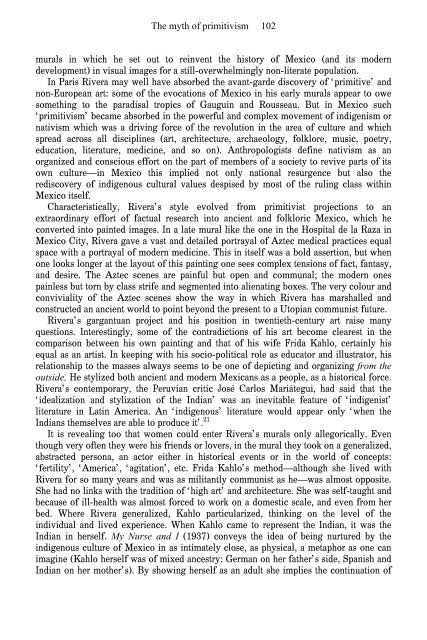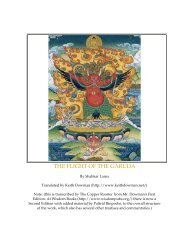Hiller - The Myth of Primitivism. Perspectives on Art - Esoteric Online
Hiller - The Myth of Primitivism. Perspectives on Art - Esoteric Online
Hiller - The Myth of Primitivism. Perspectives on Art - Esoteric Online
Create successful ePaper yourself
Turn your PDF publications into a flip-book with our unique Google optimized e-Paper software.
<str<strong>on</strong>g>The</str<strong>on</strong>g> myth <str<strong>on</strong>g>of</str<strong>on</strong>g> primitivism 102<br />
murals in which he set out to reinvent the history <str<strong>on</strong>g>of</str<strong>on</strong>g> Mexico (and its modern<br />
development) in visual images for a still-overwhelmingly n<strong>on</strong>-literate populati<strong>on</strong>.<br />
In Paris Rivera may well have absorbed the avant-garde discovery <str<strong>on</strong>g>of</str<strong>on</strong>g> ‘primitive’ and<br />
n<strong>on</strong>-European art: some <str<strong>on</strong>g>of</str<strong>on</strong>g> the evocati<strong>on</strong>s <str<strong>on</strong>g>of</str<strong>on</strong>g> Mexico in his early murals appear to owe<br />
something to the paradisal tropics <str<strong>on</strong>g>of</str<strong>on</strong>g> Gauguin and Rousseau. But in Mexico such<br />
‘primitivism’ became absorbed in the powerful and complex movement <str<strong>on</strong>g>of</str<strong>on</strong>g> indigenism or<br />
nativism which was a driving force <str<strong>on</strong>g>of</str<strong>on</strong>g> the revoluti<strong>on</strong> in the area <str<strong>on</strong>g>of</str<strong>on</strong>g> culture and which<br />
spread across all disciplines (art, architecture, archaeology, folklore, music, poetry,<br />
educati<strong>on</strong>, literature, medicine, and so <strong>on</strong>). Anthropologists define nativism as an<br />
organized and c<strong>on</strong>scious effort <strong>on</strong> the part <str<strong>on</strong>g>of</str<strong>on</strong>g> members <str<strong>on</strong>g>of</str<strong>on</strong>g> a society to revive parts <str<strong>on</strong>g>of</str<strong>on</strong>g> its<br />
own culture—in Mexico this implied not <strong>on</strong>ly nati<strong>on</strong>al resurgence but also the<br />
rediscovery <str<strong>on</strong>g>of</str<strong>on</strong>g> indigenous cultural values despised by most <str<strong>on</strong>g>of</str<strong>on</strong>g> the ruling class within<br />
Mexico itself.<br />
Characteristically, Rivera’s style evolved from primitivist projecti<strong>on</strong>s to an<br />
extraordinary effort <str<strong>on</strong>g>of</str<strong>on</strong>g> factual research into ancient and folkloric Mexico, which he<br />
c<strong>on</strong>verted into painted images. In a late mural like the <strong>on</strong>e in the Hospital de la Raza in<br />
Mexico City, Rivera gave a vast and detailed portrayal <str<strong>on</strong>g>of</str<strong>on</strong>g> Aztec medical practices equal<br />
space with a portrayal <str<strong>on</strong>g>of</str<strong>on</strong>g> modern medicine. This in itself was a bold asserti<strong>on</strong>, but when<br />
<strong>on</strong>e looks l<strong>on</strong>ger at the layout <str<strong>on</strong>g>of</str<strong>on</strong>g> this painting <strong>on</strong>e sees complex tensi<strong>on</strong>s <str<strong>on</strong>g>of</str<strong>on</strong>g> fact, fantasy,<br />
and desire. <str<strong>on</strong>g>The</str<strong>on</strong>g> Aztec scenes are painful but open and communal; the modern <strong>on</strong>es<br />
painless but torn by class strife and segmented into alienating boxes. <str<strong>on</strong>g>The</str<strong>on</strong>g> very colour and<br />
c<strong>on</strong>viviality <str<strong>on</strong>g>of</str<strong>on</strong>g> the Aztec scenes show the way in which Rivera has marshalled and<br />
c<strong>on</strong>structed an ancient world to point bey<strong>on</strong>d the present to a Utopian communist future.<br />
Rivera’s gargantuan project and his positi<strong>on</strong> in twentieth-century art raise many<br />
questi<strong>on</strong>s. Interestingly, some <str<strong>on</strong>g>of</str<strong>on</strong>g> the c<strong>on</strong>tradicti<strong>on</strong>s <str<strong>on</strong>g>of</str<strong>on</strong>g> his art become clearest in the<br />
comparis<strong>on</strong> between his own painting and that <str<strong>on</strong>g>of</str<strong>on</strong>g> his wife Frida Kahlo, certainly his<br />
equal as an artist. In keeping with his socio-political role as educator and illustrator, his<br />
relati<strong>on</strong>ship to the masses always seems to be <strong>on</strong>e <str<strong>on</strong>g>of</str<strong>on</strong>g> depicting and organizing from the<br />
outside, He stylized both ancient and modern Mexicans as a people, as a historical force.<br />
Rivera’s c<strong>on</strong>temporary, the Peruvian critic José Carlos Mariátegui, had said that the<br />
‘idealizati<strong>on</strong> and stylizati<strong>on</strong> <str<strong>on</strong>g>of</str<strong>on</strong>g> the Indian’ was an inevitable feature <str<strong>on</strong>g>of</str<strong>on</strong>g> ‘indigenist’<br />
literature in Latin America. An ‘indigenous’ literature would appear <strong>on</strong>ly ‘when the<br />
Indians themselves are able to produce it’. 21<br />
It is revealing too that women could enter Rivera’s murals <strong>on</strong>ly allegorically. Even<br />
though very <str<strong>on</strong>g>of</str<strong>on</strong>g>ten they were his friends or lovers, in the mural they took <strong>on</strong> a generalized,<br />
abstracted pers<strong>on</strong>a, an actor either in historical events or in the world <str<strong>on</strong>g>of</str<strong>on</strong>g> c<strong>on</strong>cepts:<br />
‘fertility’, ‘America’, ‘agitati<strong>on</strong>’, etc. Frida Kahlo’s method—although she lived with<br />
Rivera for so many years and was as militantly communist as he—was almost opposite.<br />
She had no links with the traditi<strong>on</strong> <str<strong>on</strong>g>of</str<strong>on</strong>g> ‘high art’ and architecture. She was self-taught and<br />
because <str<strong>on</strong>g>of</str<strong>on</strong>g> ill-health was almost forced to work <strong>on</strong> a domestic scale, and even from her<br />
bed. Where Rivera generalized, Kahlo particularized, thinking <strong>on</strong> the level <str<strong>on</strong>g>of</str<strong>on</strong>g> the<br />
individual and lived experience. When Kahlo came to represent the Indian, it was the<br />
Indian in herself. My Nurse and I (1937) c<strong>on</strong>veys the idea <str<strong>on</strong>g>of</str<strong>on</strong>g> being nurtured by the<br />
indigenous culture <str<strong>on</strong>g>of</str<strong>on</strong>g> Mexico in as intimately close, as physical, a metaphor as <strong>on</strong>e can<br />
imagine (Kahlo herself was <str<strong>on</strong>g>of</str<strong>on</strong>g> mixed ancestry: German <strong>on</strong> her father’s side, Spanish and<br />
Indian <strong>on</strong> her mother’s). By showing herself as an adult she implies the c<strong>on</strong>tinuati<strong>on</strong> <str<strong>on</strong>g>of</str<strong>on</strong>g>




